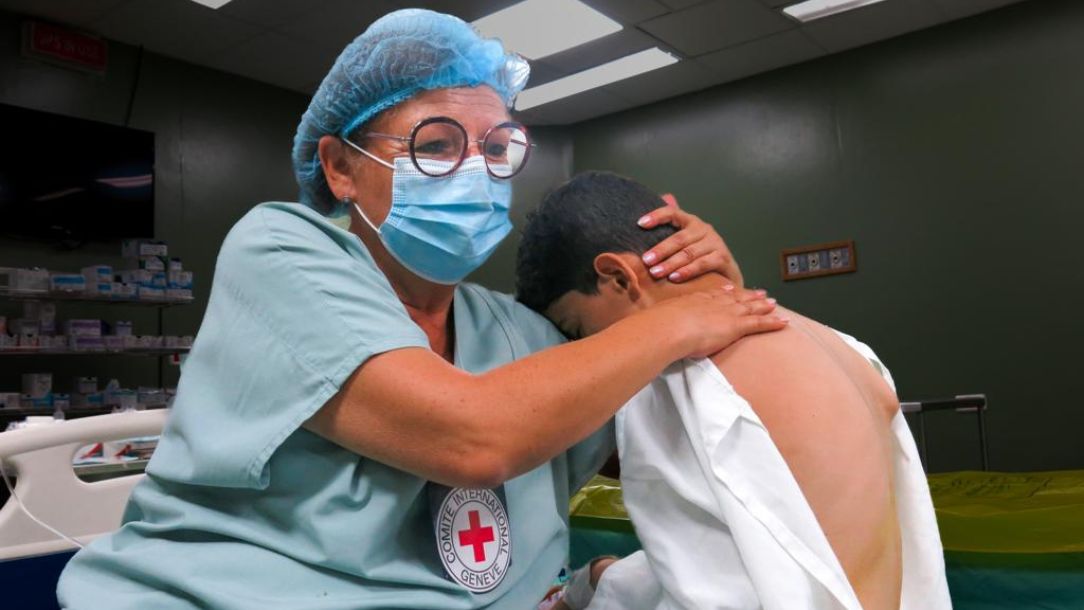Suzanne was part of the ICRC medical team at the Al-Shifa hospital in Gaza. Before it stopped functioning, she messaged colleagues and said:
“Tonight it was very noisy. The explosions are coming closer. Whenever I eat something, I feel bad, knowing that many people here have nothing.”
Her unsettling words echo the dire reality facing humanitarian workers in Gaza, where violence has escalated to unprecedented levels. For Suzanne and her colleagues at the International Committee of the Red Cross (ICRC), the struggle is not only against the relentless airstrikes but also against a humanitarian crisis that deepens with every passing day. “We are so concerned for our colleagues in Al-Shifa,” she wrote, encapsulating a moment of profound empathy amidst despair.
The emotional toll on the medical team reaches a breaking point when one of her colleagues, overwhelmed by grief, breaks down in the operating theater after receiving news that ten family members and a best friend had been killed in Rafah. “I have nothing but respect for my colleagues here,” he said, embodying the spirit of resilience that persists despite the overwhelming odds. Tragically, he is not alone; many humanitarian and health workers have been killed while performing their critical duties.
A Grim Reality: Violence Against Humanitarian Workers
Since the start of 2024, at least 28 volunteers and staff members have lost their lives while executing humanitarian tasks in conflict zones. This alarming statistic represents one of the highest rates of violence against Red Cross and Red Crescent teams ever documented. “When humanitarian workers are targeted, it not only compromises the immediate care they provide but also sends shockwaves through their communities,” states Dr. Raj Patel, an expert in humanitarian law.
- Humanitarian workers face immense danger while providing essential services.
- Increased violence is correlated with worsening humanitarian crises.
- Calls for international law protections have intensified amidst the chaos.
The ICRC has persistently called for the protection of hospitals, medical staff, and humanitarian workers under international humanitarian law. The ongoing clashes near hospitals exacerbate the risks, not just for healthcare providers, but for patients and families seeking refuge. As Dr. Emily Roth, a public health analyst, notes, “The destruction of healthcare facilities is not only a violation of humanitarian principles but also a long-term setback for public health in war-torn regions.”
Urgent Medical Needs Amidst Despair
As fighting rages on, the situation is compounded by a lack of resources. With over 45,000 fatalities reported, more than 75% of Gaza’s population is displaced, grappling with shelter, food, and basic medical care. The acute demands of this humanitarian crisis leave healthcare workers like Suzanne in an incessant battle for survival against overwhelming odds.
“Our needs right now exceed our capabilities,” she said in a fleeting moment of candor. “We are treating infections and wounds with little to no supplies, and people who come to us are in dire straits.” Reports from the World Health Organization indicate significant disease outbreaks; in just the initial months of the conflict, over 54,866 acute respiratory infections and 33,551 cases of diarrheal diseases have been documented. This rise in illness is particularly alarming given the already high rates of malnutrition among the population.
Unsanitary conditions, lack of clean water, and food scarcity contribute not only to widespread illness but also exacerbate medical emergencies. Basic medications like painkillers and antibiotics are scarce, plunging the humanitarian staff further into a critical care crisis.
Humanitarian Efforts Under Siege
The Palestine Red Crescent Society (PRCS) continues to mobilize essential medical aid and evacuate the sick and wounded, risking their lives amid relentless bombardments. “Every day, we see more patients arriving with life-threatening conditions that could have been easily managed under normal circumstances,” noted Dr. Fatima Saeed, a physician who has worked tirelessly through the chaos. “However, our resources are dwindling, and we are forced to make impossible choices.”
This relentless cycle of violence and healthcare failure further fosters a sense of desperation among civilians. The emotional and mental health repercussions are equally devastating. With rising trauma levels, the psychological scars run deep. “We must prepare for not just the physical impact of this conflict, but the long-term mental health crisis that is inevitable,” says Dr. Aaron Lim, a psychologist observing the situation closely.
The plight of humanitarian workers like Suzanne serves as a microcosm of the broader struggles faced by the civilian population in Gaza, where hope often seems futile amidst the wreckage. Yet, the stories of resilience permeate even the darkest corners of this conflict. Colleagues support each other in their endeavors, forming lifelines of solidarity that stave off despair.
As the world watches, the urgent need for action grows more acute. The ICRC and other humanitarian agencies are not just calling for relief efforts but also urging the international community to ensure accountability for violations of humanitarian law.
There is little doubt that what unfolds in Gaza will influence the humanitarian landscape for years to come. The echoes of Suzanne’s reflections remind us that behind every statistic lies a human story of courage in the face of insurmountable adversity.
Source: www.redcross.org.uk


